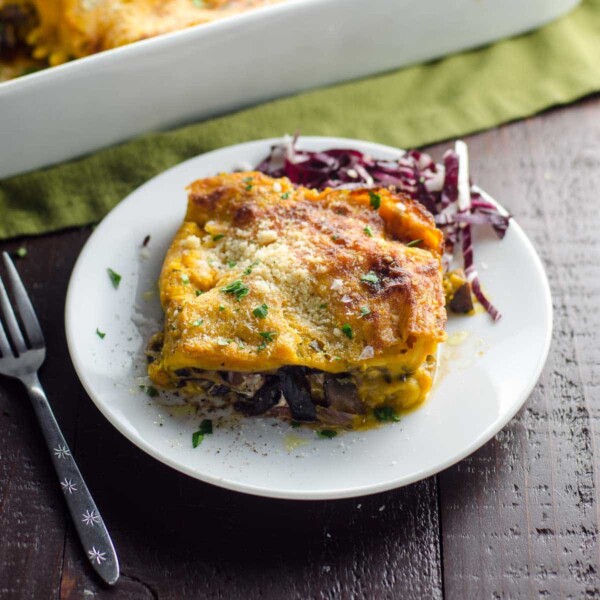This post may contain affiliate links. Learn more.
This wonderfully flavorful vegetarian carbonara recipe uses the traditional Italian carbonara sauce technique but substitutes thinly sliced ramps and asparagus for the pork. In that brilliant Italian way, it feels special but only takes 20 minutes to make. Psst…looking for regular carbonara? There you go!

Why we love this recipe
This quick and easy pasta has so much going for it. The silky carbonara sauce that coats each spaghetti strand is the stuff of dreams. Pairing it with an abundance of verdant spring vegetables takes it to a whole different dimension.
- Our foolproof technique guarantees a perfect sauce
- It’s so rich and savory that you won’t miss the meat
- You can easily swap in other seasonal veggies depending on the time of year
I first published this recipe here way back in 2010. I’ve updated the post for clarity and tweaked the recipe to todays’s standards of perfection, but in essence it remains the same.
What you’ll need
Here’s a glance at the ingredients you’ll need to make this recipe.

- You can use thin or thick stalks of asparagus — whatever’s available. Remove any woody parts, then thinly slice the stalks, leaving the tips intact for a little bit of textural variety.
- Buying ramp leaves rather than whole ramps with the bulbs still attached is the best way to ensure they’ve been harvested sustainably. If you don’t have ramps, you can substitute regular leeks according to the instructions below.
- A combination of pecorino and parmesan takes you through the entire spectrum of savory goodness, from sharp and salty to smooth and almost sweet.
- Whole eggs and egg yolks combine to create just the right sauce texture when mixed with the cheeses and a bit of starchy pasta cooking water.
How to make it
Here’s what you’ll do to make a beautiful batch of vegetarian carbonara. You can see the steps in action in the video that accompanies this post, and get all the details in the recipe card below.

- In a large bowl, whisk together the eggs, yolks, pecorino, parmesan, and pepper. Choose a heat-resistant bowl which, if possible, can sit comfortably over your pasta pot.
- Sauté the asparagus in the butter and olive oil. Add the ramp leaves and cook for another minute or two, just until wilted.
- Cook the spaghetti al dente in well-salted water. Right before the timer dings, scoop out 1/2 cup of the cooking water and slowly whisk it into the egg mixture.
- Add the steaming pasta to the bowl and toss to coat with the sauce. It may thicken enough from the residual heat, or you may need to set the bowl over the pasta cooking water to encourage it to become silky and glossy and cling to each strand. When this happens, add the cooked vegetables and toss to combine. Serve immediately.
Expert tips and FAQs
You probably don’t need me to tell you that Italians are absolute geniuses with sauce. One of the best traditional Italian sauce tricks is incorporating a bit of hot, starchy pasta cooking water into a sauce to bring a dish together.
In many cases, like with cacio e pepe, Alfredo, and tomato-based sauces, you can actually finish cooking the pasta in a skillet with the sauce and a ladle of pasta water, but with carbonara, the direct heat would risk scrambling the eggs.
Sometimes the residual heat from the pasta is enough to thicken Carbonara sauce on its own. But I find it’s not totally predictable.
So here’s a great trick: if your sauce needs a little help thickening, set the bowl over the pot of hot water in which you just cooked the spaghetti, tossing constantly with tongs until the sauce becomes silky and dreamy and clings just so to the spaghetti. It takes but a moment.
100%. If ramps aren’t in season or you can’t find them, use leeks.
If asparagus isn’t available, you can pretty much go nuts with the substitutions. A great, super-savory option that mimics some of the qualities of traditional carbonara is to toss in shiitake bacon or sautéed mushrooms.
Or use our favorite sautéed spinach or zucchini. In any case, stir the veggies into your carbonara at the end as indicated in the recipe.
Carbonara needs to be made right before serving. It only takes about 20 minutes, so it’s do-able even on a weeknight. If you do have leftovers, you can store them in an airtight container in the fridge for a day or two. Reheat on half power in the microwave or in a double-boiler, and expect the texture to be a little different.
More favorite vegetarian spaghetti recipes

Hungry for more?
Subscribe to Umami Girl’s email updates, and follow along on Instagram.

Vegetarian Spaghetti Carbonara with Asparagus and Ramps
Ingredients
- 1 pound (454 grams) asparagus
- 5 ounces (142 grams) ramp leaves OR 2 large leeks
- ½ cup 2 ounces/(57 grams) grated pecorino cheese
- ¼ cup 1 ounce/(28 grams) grated parmesan cheese
- ¼ teaspoon freshly ground black pepper
- 2 tablespoons (30 ml) olive oil
- 2 tablespoons (28 grams) butter
- 2 whole eggs plus 2 egg yolks
- 1 pound (454 grams) spaghetti
Instructions
- Bring a large pot of well-salted water to a boil.
- Meanwhile, remove any woody parts of the asparagus stalks. Thinly slice the stalks, leaving the tips intact.
- Thinly slice the ramp leaves.
- In a large bowl, whisk together the eggs and yolks, pecorino, parmesan, and pepper. Set aside.
- Heat the oil and butter in a 12-inch pan over medium-high heat.
- Add the asparagus and cook, stirring occasionally, until tender, 3 to 5 minutes. Stir in the ramp leaves and cook until just wilted, a minute or two. Remove from the heat and cool slightly.
- Cook the pasta until al dente in the boiling, salted water.
- Toward the end of cooking, scoop out 1/2 cup of pasta cooking liquid. Slowly pour it into the egg and cheese mixture, whisking constantly.
- When pasta is al dente, use tongs to transfer it to the bowl with the egg mixture. Save the hot cooking water in the pot.
- Toss well to coat pasta with the eggs. You’re looking for the mixture to thicken into a nice silky sauce that clings to each strand and isn’t watery. This may happen on its own from the residual heat of the pasta, but if it needs a little help, carefully hold or set the bowl over the pot of hot cooking water and continue tossing just until the sauce thickens.
- Gently stir in the cooked ramps and asparagus until well-distributed. Serve immediately.
Notes
- Buying ramp leaves rather than whole ramps with the bulbs still attached is the best way to ensure they've been harvested sustainably. If you've bought or foraged them with the bulbs attached, trim the roots and then slice the whole ramp. Add the sliced bulbs to the pan at the same time as the asparagus to give them a few extra minutes to mellow.
- If using leeks instead of ramps, here's how to prep them. Remove the roots and dark green parts. Halve the white and light green parts lengthwise and then crosswise into thin half-moons. Leeks can retain a lot of grit, so be sure to wash them very well, either after halving or in a salad spinner after slicing.
- Leeks will need to cook for a bit longer than the asparagus, so add them to the pan about five minutes before, rather than after.
- Substituting other seasonal vegetables: If asparagus isn't available, you can pretty much go nuts with the substitutions. A great, super-savory option that mimics some of the qualities of traditional carbonara is to toss in shiitake bacon or sautéed mushrooms. Or use our favorite sautéed spinach or zucchini. In any case, stir the veggies into your carbonara at the end as indicated in the recipe.
- Carbonara needs to be made right before serving. It only takes about 20 minutes, so it's do-able even on many weeknights.
- If you do have leftovers, you can store them in an airtight container in the fridge for a day or two. Reheat on half power in the microwave or in a double-boiler, and expect the texture to be a little different.
- I first published this recipe here way back in 2010. I've updated the post for clarity and tweaked the recipe to todays's standards of perfection, but in essence it remains the same.
Nutrition
Nutrition information is automatically calculated, so should only be used as an approximation.
Hungry for more?
Subscribe to Umami Girl’s email updates, and follow along on Instagram.














Great info. Lucky me I ran across your website by accident (stumbleupon).
I’ve book-marked it for later!
Hello, I am a fresh freelance web designer in the beginning stages and I’m
in need of a portfolio. Are you interested in an online site design completely free?
Sounds fantastic.Simple and Divine.Thank you sor share.
A good question. I think I’m just going to be self-indulgent this summer and put some more food posts right alongside the racing stuff. I honestly don’t know what I like more about Saratoga, the track or that amazing farmer’s market! And by the way, I’m very serious about your doing a memoir (if you’re not working on one already). When I’m not being a degenerate gambler or in the kitchen, I’m a writer/editor. . .feel free to contact me privately if you ever want to discuss.
Inspired by this awesome recipe, I did a little twist on it where I skipped the bacon, plated the dish on a flat plate and around the edges I put little demitasse scoops of asparagus pesto (made with lower parts of stalks, scapes, pinoli, olive oil) and also harissa, then garnished w the asparagus spears as well. The harissa added a little smokiness and both helped in terms of. . .wait for it. . . umami. Might do a write up w pics on blog soon.
Sounds fabulous, Peter. Do you have a food blog too, or might this make it into the company of horses?
Hi Will and Kelsey, thanks! It’s a lot easier than you’d think to make the pasta look like that—I’m definitely not a hairspray and tweezers type. I just twirled it around a big serving fork and put it in the bowl. For me, a big key to styling is to plate a little (or sometimes a lot) less food than you might otherwise. Good luck!